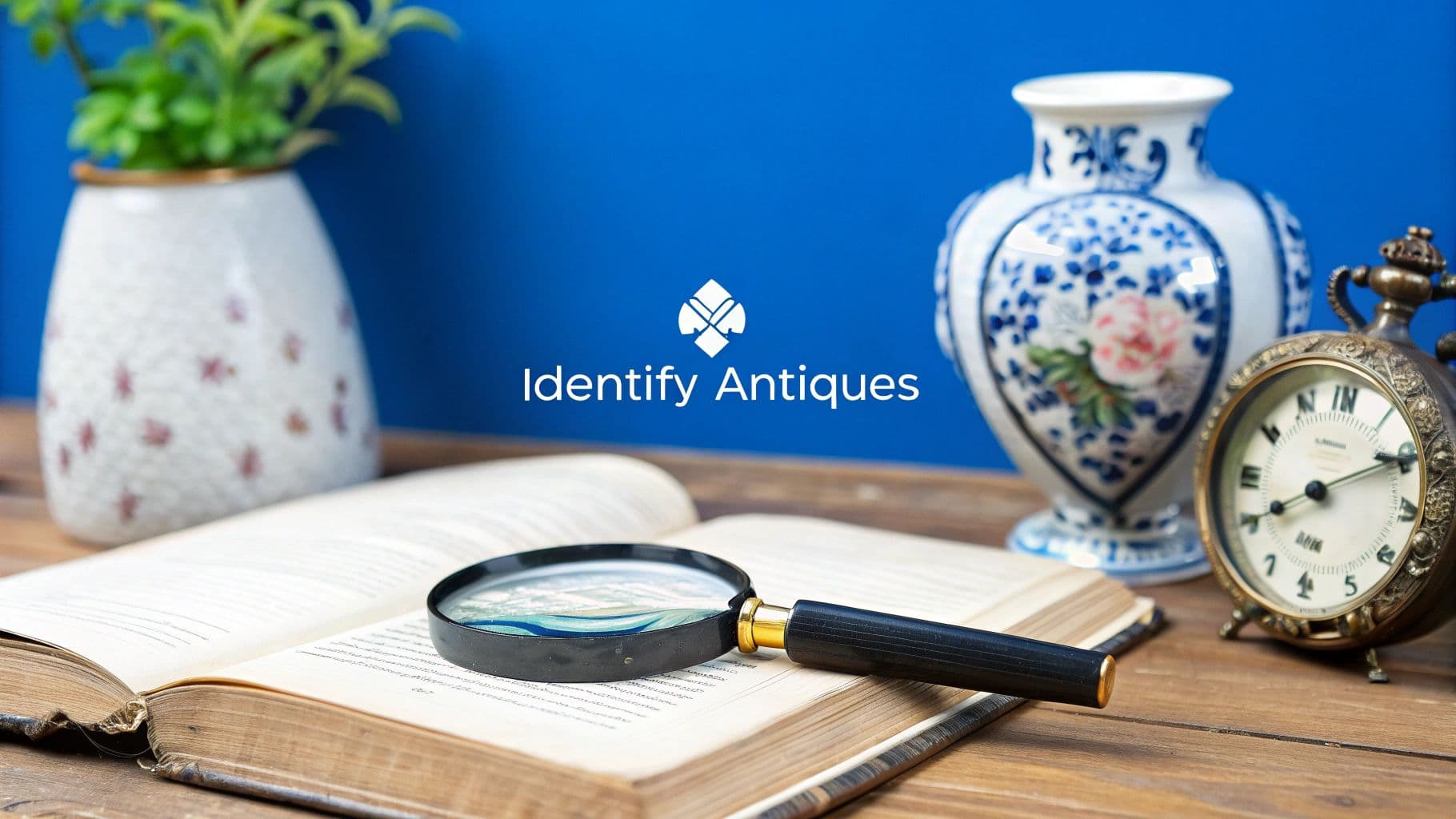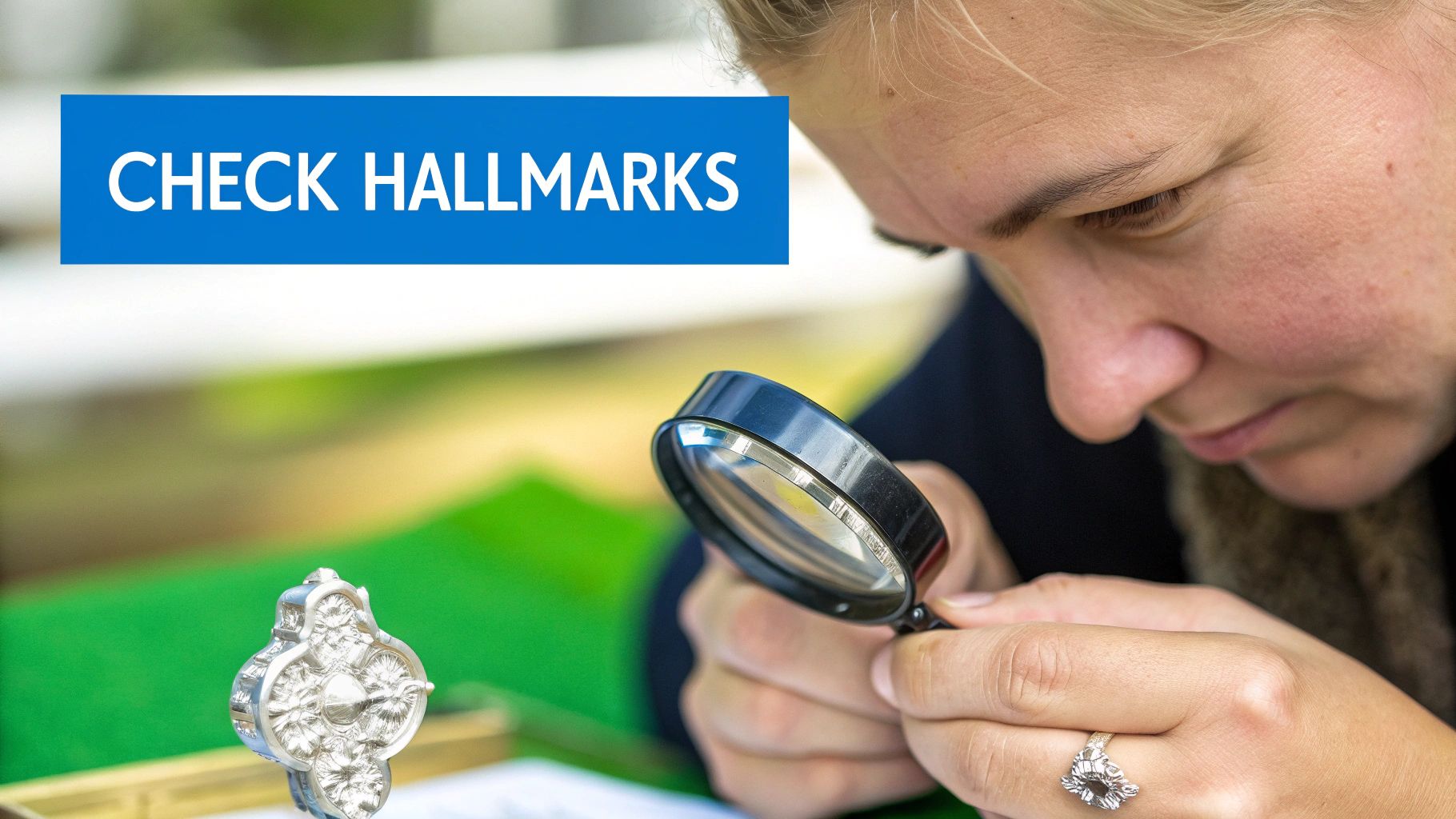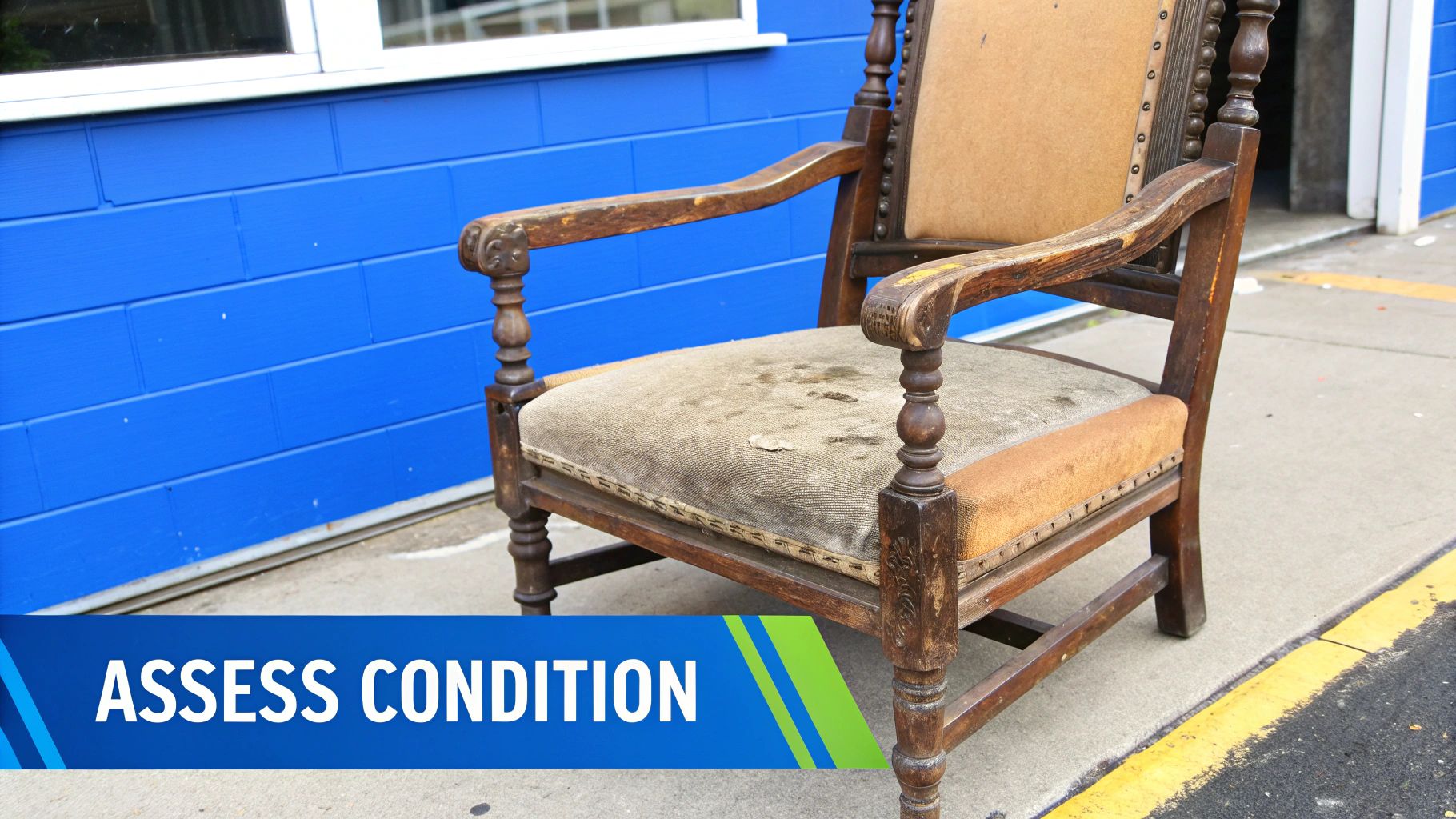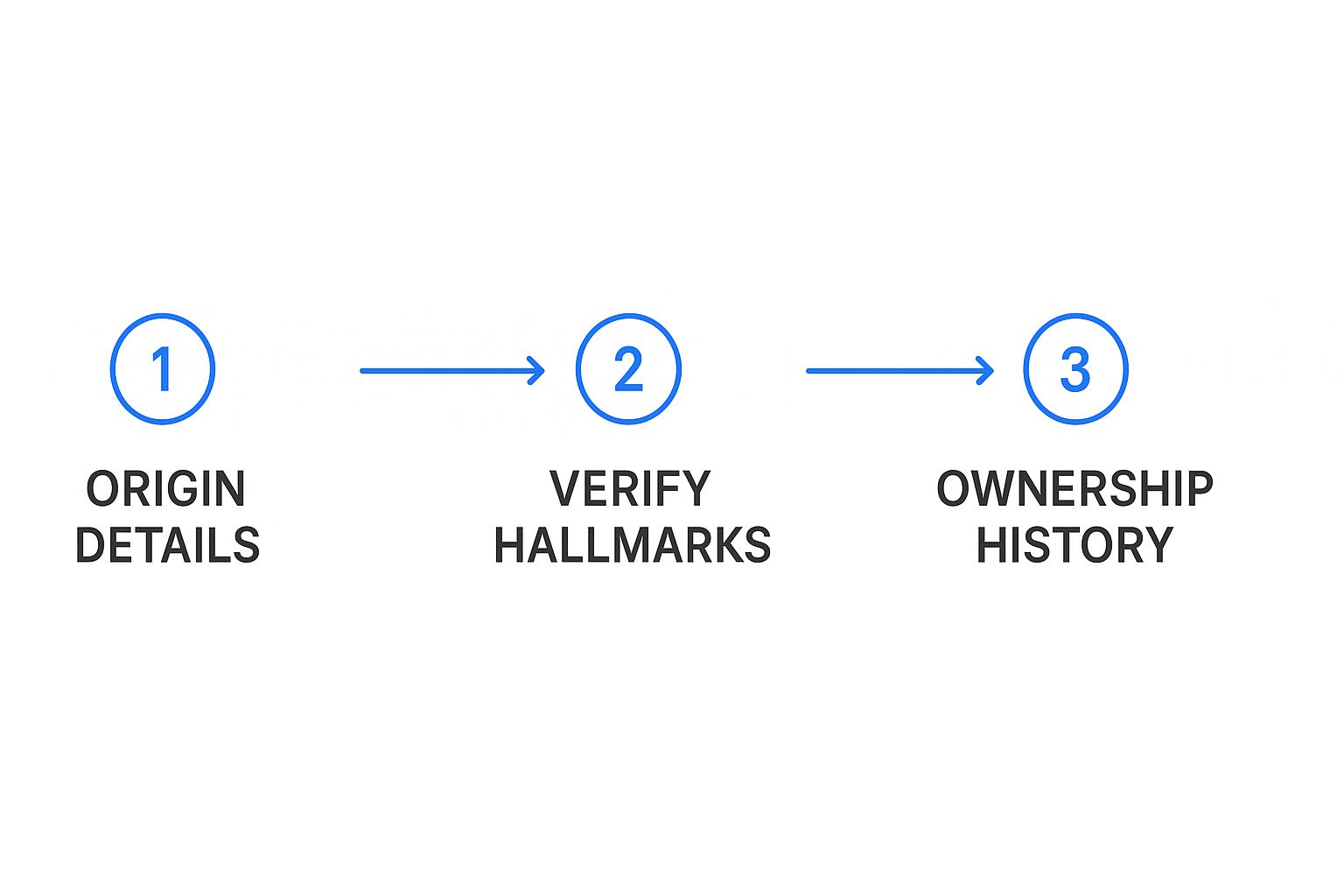How to Identify Valuable Antiques A Pro's Guide

Step 1: Uncover the Story with Provenance and Authenticity
When you're first starting out, it's easy to think that the older an item is, the more valuable it must be. But that's a common misconception. In reality, the most important factor is an antique's story—what we in the business call its provenance.
A piece with a clear, documented history of ownership will almost always command a higher price than an identical one with a mysterious past.

Think of yourself as a detective. Every antique has a story, but a valuable one has a history you can actually trace. Your job is to piece together the item's journey, and the best place to start looking for clues is on the object itself.
These identifying marks are the fingerprints left behind by the people who made or owned the piece.
- Maker’s Marks: Look for stamps, symbols, or signatures from the artisan or company. A classic example is the famous intertwined "C"s you'll find on Sèvres porcelain.
- Hallmarks: These are a godsend on silver and gold. The tiny stamps can tell you the metal's purity, where it was assayed, and often the exact year it was made. British silver hallmarks are a fantastic roadmap of an item's origins.
- Labels or Signatures: While a signed piece of furniture from a master like Thomas Chippendale is incredibly rare, you might get lucky and find an original paper label from the manufacturer still attached.
The Power of a Verified Past
Piecing together and verifying this history is what separates serious collectors from casual buyers. It’s not just about a cool story; it’s about tangible value. An item with strong, documented provenance can be worth 20% to 40% more at auction, simply because it eliminates the guesswork and confirms the item's significance.
Think of it this way: you have two nearly identical pocket watches. One is just an old watch. The other has paperwork proving it was carried by a soldier during a famous battle. Which one is more desirable? The story creates real, monetary value.
Before you can confidently price an item, you need to know what you have. Understanding these markers is the first step, whether you're building a personal collection or getting ready to sell. If you're thinking about that next step, our guide on selling antiques and collectibles offers some great practical advice.
A verified history gives you the confidence to ask for a fair price and the evidence to back it up.
Quick Guide to Authenticity Markers
To help you get started, here's a quick summary of the key markers to look for when you're beginning to assess an antique's authenticity and potential value.
| Marker Type | What to Look For | Why It Matters |
|---|---|---|
| Maker's Marks | Stamped logos, initials, or symbols on ceramics, glass, or furniture. | Directly connects the item to a specific person, workshop, or factory. |
| Hallmarks | A series of small punches on precious metals like silver and gold. | Certifies metal purity, city of origin, and often the year of creation. |
| Signatures | Handwritten or engraved names on paintings, prints, or high-end furniture. | The ultimate proof of authorship, though forgeries are common. |
| Labels & Tags | Paper or fabric labels, often in drawers or on the back of items. | Provides manufacturer details, model numbers, or original seller information. |
| Construction | Hand-cut dovetails, saw marks, types of screws, and joinery techniques. | Helps date a piece and distinguish it from modern reproductions. |
Learning to spot these details takes practice, but it's the most reliable way to start separating the treasures from the everyday old stuff. Once you know what to look for, you'll start seeing clues everywhere.
Reading the Details: Condition and Originality
Once you've done your historical homework on a piece, it's time to get hands-on and really scrutinize its physical state. I've seen countless beginners assume that "old" automatically equals "valuable," but that's a costly mistake. Condition is king. A pristine piece will almost always fetch a higher price than a damaged one, even if they're from the same maker and era.
Start by looking for signs of wear. Does it feel natural? Honest wear and tear shows up in logical places—the arms of a chair, the handle on a well-used pitcher, or the softened corners of a book. This gentle aging, which we call patina, is the story of an object's life written on its surface. Far from being a flaw, a good patina can actually increase an item's value and desirability.
But you have to learn the difference between charming patina and outright damage. Major problems like cracks, deep chips, noticeable stains, or missing parts will tank an item's value. A bad repair job is often even worse than the original damage, as it can be impossible to reverse and screams that someone was trying to hide a problem.
Assessing Originality and Repairs
Just as crucial as condition is originality. The holy grail for collectors is a piece that has all its original parts, from the first finish on a chest of drawers to the tiny screws holding its hardware in place. People will pay a serious premium for items that haven't been messed with over the years.
Here’s what to look for to spot later alterations:
- Mismatched Hardware: Do all the drawer pulls look and feel the same? Do they show similar patterns of wear? Finding modern, machine-made screws on a piece of pre-1850 furniture is a huge red flag.
- Refinishing Clues: A finish that looks too perfect, glossy, or plasticky for its supposed age is a dead giveaway. Look for sanding marks that go against the wood grain. Original finishes often feel softer to the touch and have a depth and subtlety that modern varnishes lack.
- Evidence of Repairs: Check underneath a piece. Modern glues, metal brackets, or braces are obvious signs of a later fix. Also, look for spots where the wood color or finish is just slightly off, indicating a patch-up job.
A key thing I've learned is that preservation always trumps restoration. A careful, professional structural repair might be necessary to keep a piece from falling apart, but cosmetic "improvements" almost always hurt an antique's historical integrity and its value on the market.
For some items, like sterling silver, these details are stamped right onto the object itself. The image below shows a classic set of British silver hallmarks.

Think of these tiny stamps as a secret code. Each one tells a story, revealing the city where it was assayed (the anchor for Birmingham), its silver purity (the lion passant), the date it was made, and the silversmith's personal mark. Learning to read these hallmarks lets you instantly confirm an item’s authenticity and history, which has a direct and powerful impact on its value.
Gauging Current Market Demand

Here’s a hard truth many new collectors learn the expensive way: a beautiful, authentic antique is only worth what someone is willing to pay for it right now. This is where market demand comes in, and it's the biggest variable in the valuation equation. Tastes change, and what was all the rage a decade ago might just be gathering dust today.
Take furniture, for example. The sleek, clean lines of Mid-Century Modern pieces are absolutely on fire. Designers and homeowners can't get enough of brands like Herman Miller or the iconic Danish modern style. On the flip side, some ornate Victorian furniture, despite its historical importance and craftsmanship, can be a tough sell in a market that currently leans toward minimalism.
Keeping Your Finger on the Pulse
So, how do you get a real feel for what's hot and what's not? You need to know where the actual transactions are happening. Forget dusty old price guides; your best bet is to track recent auction results on sites like LiveAuctioneers or Bidsquare. This gives you hard data on what people are actually paying for items today.
The key takeaway is that an antique's value is fluid. It's constantly influenced by everything from a feature in an interior design magazine to the set decor of a popular TV show. Staying on top of these cultural shifts gives you a massive advantage.
This is true even for niche markets. The antique shelves market, for instance, was valued at around $500 million in 2025 and is expected to grow by 7% annually through 2033. This isn't random; it's fueled by a growing desire for unique, character-rich storage that complements modern eclectic and sustainable design trends. You can dive deeper into these specific dynamics in the full research on antique market growth.
Understanding these trends is just as critical when you're selling. Whether you're handling an entire estate or just curating your own collection, knowing the market helps you price things to sell, not to sit. If you're managing a larger sale, our guide on average estate sale proceeds can also offer some valuable perspective.
How to Spot Fakes and Forgeries
There's nothing worse than the sinking feeling you get when you realize a prized antique is just a clever fake. Honestly, it's a gut punch. Learning to protect yourself from forgeries is one of the most important skills you can develop, and it all starts with spotting the tell-tale signs of modern manufacturing.
Forgers almost always take shortcuts, and once you know what to look for, they stick out like a sore thumb.
Take a close look at the joinery on a piece of wooden furniture, for instance. A genuine 18th-century piece should have hand-cut dovetails. They’ll be slightly irregular, with beautifully thin, delicate "pins." A modern reproduction? It's almost guaranteed to have machine-cut dovetails that are perfectly uniform and chunky. It's these tiny construction details that are incredibly difficult to fake convincingly.
Materials and Aging Clues
The materials themselves can be a dead giveaway. Does that piece of "17th-century oak" furniture feel suspiciously light in your hands? It might be made from a newer, less dense wood that's just been stained to look old. Keep an eye out for other red flags like modern screws, perfectly symmetrical carvings, or a finish that looks a little too glossy and flawless.
Artificial aging is another trick you'll see all the time. Forgers might beat a piece with chains to create "distress" or use chemicals to fake a patina.
Real wear and tear happens in logical places. An old armchair will have worn armrests and scuffed feet, not a random collection of dents on its back panel. You have to trust your common sense here—if the wear doesn't tell a believable story, it’s probably a lie.
A huge part of this process is digging into the item's history. You need to check for origin details, hallmarks, and any ownership records you can find. This handy infographic gives you a simple flow to follow for your investigation.

Following a sequence like this helps you build a solid case for an item's authenticity, layer by layer. You start with its physical characteristics and then move on to its documented past.
By training your eye to spot these red flags, you build the confidence to tell a genuine antique from a forgery on the spot. It's how you protect your investment and, just as importantly, the integrity of your collection.
When to Bring in a Professional Appraiser
Even with all the research in the world, there are moments when you just need an expert's final word. Knowing when to call in a professional appraiser is a crucial skill in itself.
If your homework suggests you’re holding a potentially high-value item, or if you need an official valuation for something serious like insurance or estate planning, it’s time to seek a qualified opinion.
It's important to understand that an informal verbal estimate from a dealer is not a formal appraisal. A dealer is simply telling you what they're willing to pay—a number shaped by their current inventory needs and, of course, their profit margin. A certified appraiser, on the other hand, provides an unbiased, thoroughly researched opinion of fair market value.
Finding a Reputable Expert
So, where do you find a trustworthy professional? Your best bet is to go through established organizations. Groups like the Appraisers Association of America (AAA) or the International Society of Appraisers (ISA) hold their members to strict ethical codes and demand proven expertise. This is your assurance that you're getting an assessment based on cold, hard facts—not just a gut feeling.
When you hire a pro, expect a deep dive. High-end buyers rely heavily on these expert appraisals, which consider everything from an antique's age (often verified with scientific methods) to its sales history at major auctions. We’ve all seen how top-tier pieces can sell for multiples of their starting estimates. For a closer look at how experts value collectibles, you can explore the latest market analysis.
A formal, written appraisal is your official document of worth. It will detail the item’s characteristics, condition, and provenance, and provide a well-supported value, often citing comparable sales. This is your ultimate proof for any situation.
Having that concrete evidence from an appraisal is vital, whether you're trying to insure a precious family heirloom or preparing for a major sale. For instance, knowing the official value of key items is a non-negotiable step before you learn how to run an estate sale and liquidate assets effectively.
Common Questions About Identifying Antiques
As you get your feet wet in the world of antiques, you'll find the same questions pop up time and again. Getting a handle on these common sticking points is the fastest way to build your confidence and learn to spot a real treasure. Let's dig into a few of the most frequent ones I hear.
What Is the Single Most Important Factor?
While things like rarity and condition are obviously huge, provenance is the real game-changer. It’s the documented history that connects an item to a famous person, a renowned maker, or a significant historical event.
An object in just fair condition but with rock-solid provenance can easily be worth more than a pristine piece with no story. That verifiable history is what elevates a nice old chair into a true piece of history.
Should I Restore an Antique or Leave It As Is?
This is a classic dilemma, but for collectors, the answer is almost always the same: leave it alone. In nearly every case, leaving an antique in its original, untouched condition is the key to preserving its maximum value.
Seasoned collectors and dealers prize original finishes and the beautiful, natural patina that takes centuries to develop. While a professional repair to fix a wobbly leg might be necessary for stability, cosmetic "improvements" like stripping a finish will almost always tank its market value. When in doubt, always talk to a professional conservator before you even think about making a change.
How Can I Spot a Modern Reproduction?
The secret is to look for shortcuts and signs of modern tools. Fakes and reproductions often give themselves away with details that are just a little too perfect or don't quite make sense.
- Look at the Details: Check for perfectly symmetrical carvings that scream machine-made, or modern hardware like Phillips-head screws where there should be hand-forged nails.
- Analyze the Wear: Is the wear and tear logical? Authentic aging happens on functional spots—think chair arms, drawer pulls, and the feet of a chest. Artificial "distressing" often looks random and poorly placed.
- Question the Materials: Does the wood, glass, or metal feel right for the period? A "walnut" piece that feels suspiciously light or uses a type of wood not available in its supposed country of origin is a huge red flag.
Does a Maker's Mark Guarantee Value?
A maker's mark doesn't guarantee value on its own, but it's a massive piece of the puzzle. Think of it as your best starting point for confirming authenticity, age, and where an item came from.
The final value, however, still comes down to the maker’s reputation, the item's condition, how rare it is, and what the market wants right now. A mark from a legendary artisan like Tiffany or a master furniture maker like Chippendale will always carry much more weight than a mark from a mass-production factory of the same era.